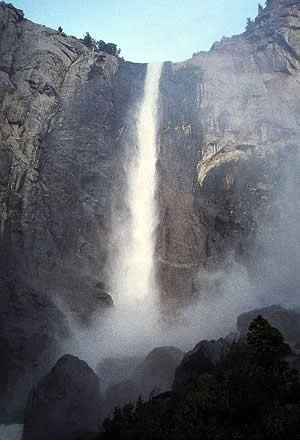We usually think of waterfalls as merely streams or rivers that happen to encounter a sudden, sheer drop in the terrain as they flow along. But geologists point out that most falls have far more complicated origins.
Many of the world's tallest falls, for example, are "hanging tributaries" - streams cut off along the rims of glacier-gouged fiords and valleys when the ice sheets of the last Ice Age receded.
Some waterfalls occur where crustal subsidence along a fault suddenly dropped the bottom out of an established river system.
 But the most important force in the creation of a major cataract is usually simply erosion of the river channel by the waters of the river itself. Where a river that has been flowing over hard bed-rock, such as granite, abruptly encounters soft sedimentary layers, the latter wear away more rapidly; thus, as time passes, the erosion-resistant bedrock is left standing as a precipice above an ever deepening chasm, pounded by a foaming barrage.
But the most important force in the creation of a major cataract is usually simply erosion of the river channel by the waters of the river itself. Where a river that has been flowing over hard bed-rock, such as granite, abruptly encounters soft sedimentary layers, the latter wear away more rapidly; thus, as time passes, the erosion-resistant bedrock is left standing as a precipice above an ever deepening chasm, pounded by a foaming barrage.
In the seemingly eternal journey of a river from the mountains to the seas, even the mightiest cataract is fated to be but a temporary phenomenon.
No more renowned waterfalls roil the rivers than Africa's Victoria Falls and North America's Niagara. The former stands where erosion undercut soft sedimentary layers beneath the Zambezi River's volcanic bedrock, while the latter's cliff was cut by the glaciers of the last Ice Age. Like waterfalls everywhere, both these colossi are relentlessly consuming their own rock foundations.
Surprisingly, a big waterfall's erosion proceeds chiefly from its base upward. This is because the energy of the falls excavates a "plunge pool" at the foot of the escarpment, undermining it and continuously bringing down chunks of rock from above. As a result, cataracts retreat upriver (Niagara's Horseshoe Falls, for instance, is retreating at a rate of about five feet per year) and decrease in height with the years.
Where swift, thin cascades plunge down sheer mountainsides or glacier-gouged valley walls, erosion usually decays the falls in a notch from the top down. But however erosion occurs, every waterfall must ultimately surrender to the persistent leveling force of the water, and its life is brief in the enduring story of the river.